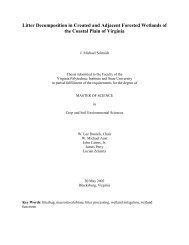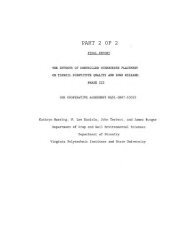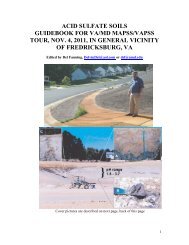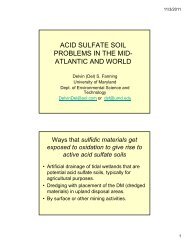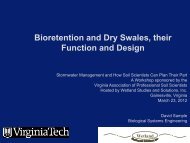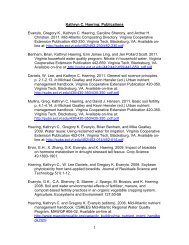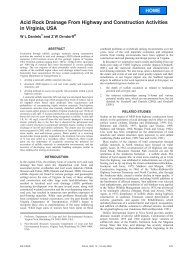Remediation of PAH-Contaminated Soils and Sediments: A ...
Remediation of PAH-Contaminated Soils and Sediments: A ...
Remediation of PAH-Contaminated Soils and Sediments: A ...
Create successful ePaper yourself
Turn your PDF publications into a flip-book with our unique Google optimized e-Paper software.
The addition <strong>of</strong> inorganic nutrients compensates for limiting nutrients values in<br />
the waste material. The optimum C:N:P ratio for degrading hazardous wastes is<br />
reportedly between 100:10:1 (Straube et al., 2003) <strong>and</strong> 300:10:1 (Eweis et al.,<br />
1998). Adding too much <strong>of</strong> any nutrient can greatly increase costs. Mixing,<br />
associated with tillage, breaks apart soil aggregates, exposes <strong>PAH</strong>s once<br />
entrapped within the aggregates to biotic <strong>and</strong> abiotic degradation <strong>and</strong><br />
homogenizes <strong>PAH</strong> levels in the soil. During l<strong>and</strong>farming, it is possible to<br />
enhance the bioavailability <strong>and</strong> degradation rate <strong>of</strong> the rapidly desorbable<br />
fraction in large pores, but not the slowly desorbable fractions associated with<br />
organic matter <strong>and</strong> smaller pores (Harmsen, 2004). Microorganisms cannot enter<br />
into pores smaller than their own size, so <strong>PAH</strong>s strongly sorbed to organic matter<br />
are slowly degraded. The biodegradation <strong>of</strong> the slowly degradable fractions is<br />
thus controlled by diffusion (Harmsen et al., 2007).<br />
Reducing <strong>PAH</strong>s to acceptable levels through l<strong>and</strong>farming can be a lengthy<br />
process <strong>and</strong> <strong>of</strong>ten does not result in levels low enough to meet EPA st<strong>and</strong>ards.<br />
In one study in Holl<strong>and</strong>, rapid degradation <strong>of</strong> <strong>PAH</strong> compounds (550 mg kg -1 ) in<br />
dredge sediment occurred within the first year, followed by slow degradation for<br />
the next seven years. After 15 years, <strong>PAH</strong> levels (22 mg kg -1 ) were similar to the<br />
background soils in the same area (Harmsen et al., 2007).<br />
Phytoremediation<br />
Phytoremediation is an on-site remediation strategy that uses plants to reclaim<br />
contaminated areas mainly through increasing microbial activity in the<br />
rhizosphere while breaking down organic compounds in contaminated soils by<br />
metabolic processes (Salt et al., 1995; Barter, 1999; Liste <strong>and</strong> Alex<strong>and</strong>er, 2000;<br />
Binet et al., 2000; Dzantor <strong>and</strong> Beauchamp, 2002). The rhizosphere is the small<br />
volume <strong>of</strong> soil immediately surrounding plant roots which has much higher<br />
concentrations <strong>of</strong> root exudates, CO2 pressures, <strong>and</strong> microbial activity (20x) than<br />
surrounding bulk soil (Rovira <strong>and</strong> Davey, 1974; Hutchinson et al., 2003). Root<br />
morphology <strong>of</strong> various plant species impact phytoremediation success. Some<br />
important root morphological properties that affect the success <strong>of</strong><br />
phytoremediation include: length, surface area, mass, depth <strong>of</strong> penetration,<br />
quantity <strong>and</strong> composition <strong>of</strong> dead roots <strong>and</strong> exudates, root hairs, <strong>and</strong> bacterial<br />
<strong>and</strong> fungal associations (Hutchinson et al., 2003). Selecting species with varying<br />
root properties can be beneficial during phytoremediation efforts.<br />
Plants are thought to enhance <strong>PAH</strong> degradation mainly through mechanisms<br />
such as mobilization into the rhizosphere (thus increasing bioavailability) <strong>and</strong><br />
enhancing bacterial populations in the rhizosphere (Liste <strong>and</strong> Alex<strong>and</strong>er, 2000;<br />
Binet et al., 2000). Plant roots provide an easily degradable source <strong>of</strong> carbon to<br />
the soil (both through root turnover <strong>and</strong> exudates) which encourages microbial<br />
activity in the rhizosphere <strong>and</strong> promotes biodegradation <strong>of</strong> organic contaminants<br />
(Olson et al., 2003; Yu et al., 2006), but can also decrease <strong>PAH</strong> bioavailability<br />
through sorption (Hutchinson et al., 2003). Root contributions <strong>of</strong> carbon to the<br />
51



